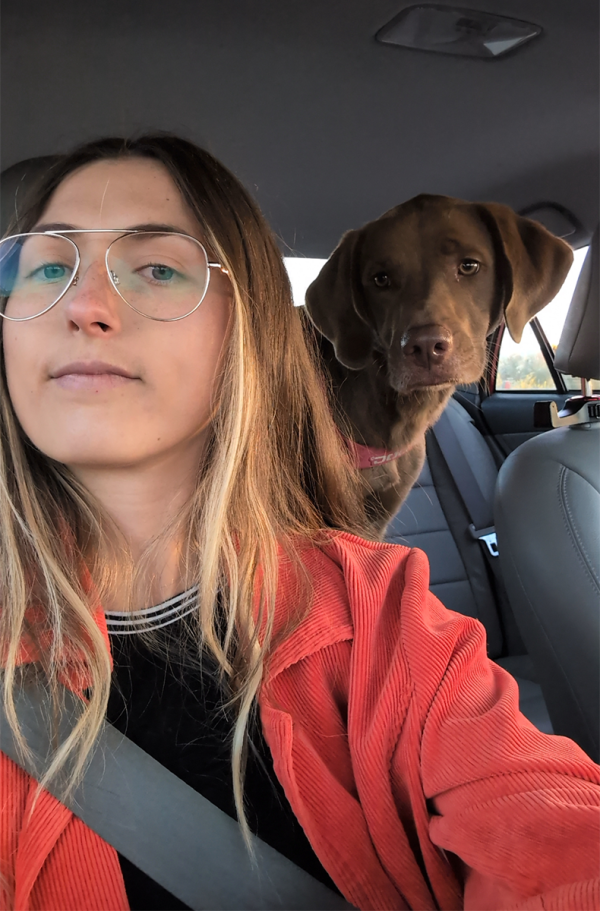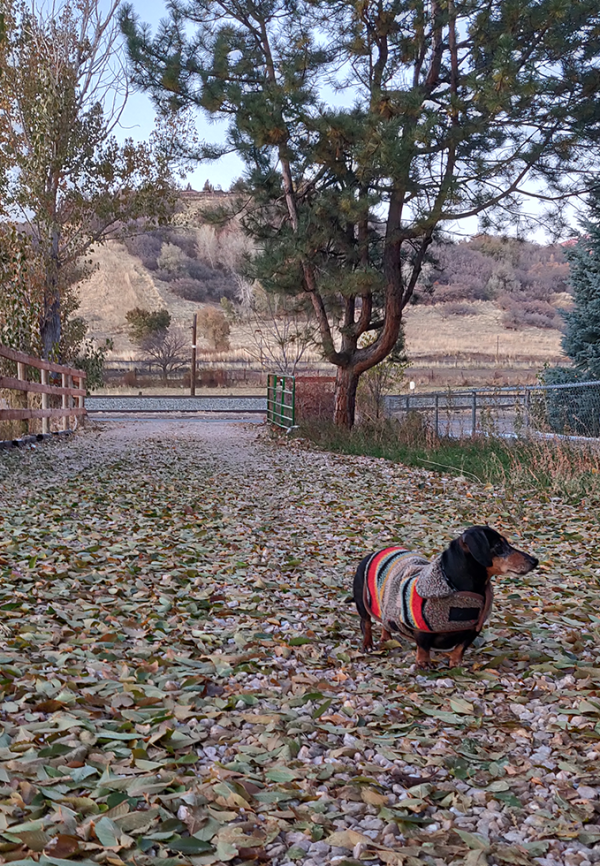
My Dog Was Bred for What!? Popular Dog Breeds and Their Long-Lost Jobs
BSM Partners recently opened its first office location in Lowell, Ark., and as one of the joys of being a professional in the pet industry, I get to bring my dog to work.
If you’ve tuned into the Barking Mad podcast, you’ve heard about Lenny. He also goes by Leonard, Len, Mr. Nibs, Lenace the Menace, and many other situational nicknames he’s more or less earned through his sweet, goofy, and high-energy personality. We discovered through a genetic test that he is part Labrador retriever and part Treeing walker coonhound, which in part explains his need for speed and constant play, his discerning nose, and seemingly selective intelligence (read: stubbornness).

Lenny and me on our way to work. (Photo by Jordan Tyler)
My husband and I have been joking that Lenny finally has a job where he can let off steam, socialize with other canine co-workers, and put that curious nose to work in new environments. But this running joke eventually got me thinking: didn’t he already have a job? Weren’t all dogs bred for a specific purpose in the beginning? And how distant is our beloved Len’s lifestyle today from his ancestral heritage?
Naturally, this line of thinking led me to explore how many beloved breeds were initially created to perform fascinating and surprising jobs that play to their natural strengths, instincts, and abilities. From bird dogs to bull baiters to badger hunters, let’s explore three well-known breeds’ old reputations and see how they stack up against their modern roles as couch potatoes.
Retrievers: The Original Good Boys
Retrievers are a common and beloved dog breed known for being highly social, athletic, and intelligent. There are many types of retrievers, but we’ll use the archetypal Labrador to learn more about this breed class.
Originally bred to retrieve hunters’ spoils in particularly cold conditions, retrievers were tailor-made for fetching downed waterfowl. They are descended from the now-obsolete St. John’s water dog, and are known to have “soft mouths,” meaning when they retrieve, they gently hold the item or animal without crushing it in their jowls.

Sully, dog of Simon Thomas, Technology Solutions Manager at BSM Partners. Sully is a retriever mix and quickly becoming Lenny's favorite co-worker. (Photo by Simon Thomas)
These dogs were bred for intense work—treading water and swimming, covering notable distances, and completing mental tasks. This hard work necessitates plenty of calories (not to mention this breed’s general food motivation). Without a tiring job to do, however, retrievers are at increased risk of excessive weight gain due to a deletion of a gene related to weight and appetite.
Of course, I’m sure there are plenty of retriever owners out there who take them hunting. It’s what they were made for, after all. However, it’s safe to say I’m not the only lucky retriever mom whose hobbies don’t include water fowling. For those of us who fall in the latter category, we can still feed our dogs’ natural proclivities without taking up a new pastime. Whether it’s a 30-minute walk every day for exercise, the occasional treat puzzle for enrichment, or regular games of fetch that satisfy their retrieving instincts, small activities that mimic their former occupations help them feel purposeful and content, and keep their bodies and brains in balance.
Bulldogs: Not Just for Show
Believe it or not, the name “Bulldog” is derived precisely from the reason these dogs were bred: to bait bulls. According to William Lawlor, researcher and author, English Bulldogs date back to medieval times, when bullbaiting (essentially putting an angry bull in the ring with dogs to see if they could bring the bull down) was a popular “blood sport.” Oh, how far we’ve come. Anyway, bullbaiting was eventually banned in 1835, but Bulldogs remained.
Once stripped of their day jobs, Bulldogs fell out of favor among the English elite, and the breed nearly died out. Luckily, introducing the breed to formal dog shows in 1859 marked a resurgence, and Bulldogs went from bloodsport bruisers to well-tempered family dogs by the 20th century.

Roland, dog of David Perez, Vice President of Product Innovation at BSM Partners. You're telling me this guy's ancestors used to fight bulls?! (Photo by David Perez)
Centuries of evolution have done little to temper the Bulldog’s natural temperament as a courageous, loyal, people-oriented companion. But the breed has also retained one disadvantageous trait: brachycephalic conformation. Brachycephalic dogs are those with “squished” snouts; think Bulldogs, boxers, and pugs. While ostensibly adorable, having a flattened face comes with a host of health implications. As a result, Bulldogs are predisposed to respiratory issues, heat intolerance, eye injuries, dental crowding, and other unfortunate conditions.
With their shortened muzzle and plentiful skin folds, today’s Bulldog owners would be smart to avoid exercising their companion in high heat, watch out for dermatitis in between those rolls, and keep an eye on the scale (unfortunately, no breed is safe from the pet obesity epidemic).
Dachshunds: Tiny Yet Tenacious
This breed has one of my favorite origin stories. In German, “dachs” means badger, and “hund” means dog. Put that together and you get: badger dog. Dachshunds were bred to have long, low bodies so they could enter a badger’s underground burrow and flush them out, making them easier for people on the surface to hunt. In some cases, Dachshunds would even go head-to-head with badgers, earning them reputations as fierce, stubborn, and bold despite their size.

Bosti, dog of Emilie Mesnier, Vice President of European Operations at BSM Partners, all bundled up for a crisp walk. (Photo by Emilie Mesnier)
These dogs were designed to be loud and fearless, with a sharp bark and even sharper personalities that persist today. The modern Dachshund is a beloved breed gaining popularity across the United States. And a fun fact: Waldi, a colorful cartoon Dachshund, served as the first official Olympic mascot.
A high drive and digging instincts make this canine companion tricky for urban environments; a hefty dose of enrichment is advised to avoid excessive barking and unwanted tunneling. Further, Dachshunds are no strangers to back problems. The breed has been associated with intervertebral disc disease (IVDD), a spinal disorder that also impacts French Bulldogs and Corgis. Thus, creating environments where these pups can work their noses, dig a little, and move around comfortably without unnecessary jumping or climbing, can help ensure today’s Dachshunds thrive, even when there’s no badger to fight.
Feeding the Breed Within
You may think your pet is your little baby. Maybe they are. But even so, deep down, they’re an animal bred for speed, stamina, protection, management, and assistance. They need nutrition and care that not only meet their present needs but also respect their physiological demands and biological roots.
Pets aren’t small humans; their physiologies, metabolisms, and nutritional needs are unique and highly nuanced. When it comes to their diets, it’s best to leave the formulating to the experts who understand those nuances. When pet food recipes are built on science and guided by professionals who understand the important genetic, metabolic, and behavioral differences between breeds, we can all feel better about filling their bowls. These purpose-built animals deserve purpose-built nutrition, after all.
Stay tuned for more breed-specific insights coming soon!
Follow us on LinkedIn for the latest updates on all things happening here at BSM Partners.
About the Author
Jordan Tyler is the Director of Media at BSM Partners and co-host of the Barking Mad podcast. She has more than five years of experience reporting on trends, best practices and developments in the North American pet nutrition industry. Jordan resides in Bentonville, Arkansas, with her husband and their four furry family members.
This content is the property of BSM Partners. Reproduction or retransmission or repurposing of any portion of this content is expressly prohibited without the approval of BSM Partners and is governed by the terms and conditions explained here.